Discussion on how to migrate to BGP-Free Core by deploying MPLS as network tunneling mechanism. Document provides step-by-step migration steps for a Juniper-based network.
Continue reading “Migrating to BGP-Free Core in Juniper Environment”
Tag: Best Practice
What Routing Protocol Should I Use?
I’m building a new ISP network, what routing protocol should I use?
Discussing BGP and comparing IGP Protocols (IS-IS vs OSPF).
Continue reading “What Routing Protocol Should I Use?”
Juniper High Availability Customer Site using AS-Prepend
Configuring Dual-CE BGP High Availability Site. This article provides Juniper Configuration Example that uses BGP AS-Prepend to identify primary and secondary paths.
Continue reading “Juniper High Availability Customer Site using AS-Prepend”
Advertising Aggregates Routes
As a BGP admin, you will often need to make decisions on the ways to partition your IP Space, which routes to advertise to the Internet and which routes to suppress.
Ideally, you’d want to aggregate your IPv4/IPv6 Space as much as possible, by only advertising aggregate prefixes (also known as supernets and summary routes) to the Internet. Practically, this would mean that your Autonomous System (AS) will originate IP prefixes assigned to you by Regional Internet Registries (RIRs) or delegated to you by Upstream Providers, while suppressing all other advertisements. If everybody were to follow this rule, the Internet routing table would be much smaller and we would not have issues with FIB exhaustion.
Continue reading “Advertising Aggregates Routes”
Cisco Configuration Blueprint – Single-Homed CE Device with EBGP
Introduction
In this example, we will show recommended configuration for a Single-homed Single CE device using private AS with an upstream ISP. It is assumed that management of this device will be performed from a dedicated server residing within Customer’s Network.
This type of setup is quite common in an environment where a dedicated firewall performing source NAT function is setup to protect customer infrastructure.
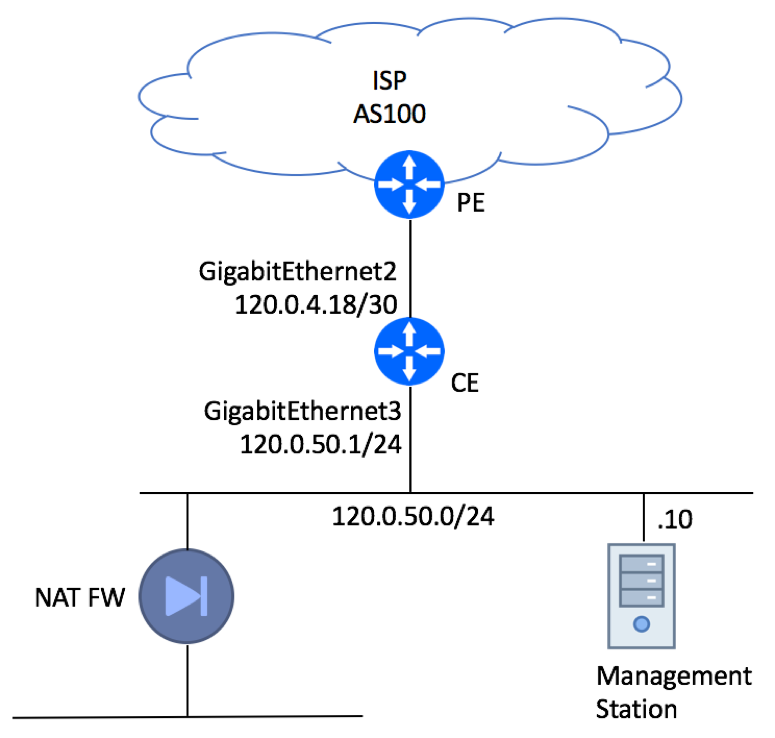
Please note, that the Management Station is connected directly to the LAN interface for illustration purpose only. In real production deployments, Management Station must be protected by a firewall.
BGP Configuration
BGP configuration can be split in the following tasks:
- Accept the default route from the ISP while discarding all other advertisements that might be sent to your CE
- Advertise your subnet (120.0.50.0/24) while making sure that no other routers are erroneously injected
- Secure BGP session by configuring a MD5 key
The actual configuration is comprised of the following blocks:
- Configure Two prefix lists – one with the subnet you’ll advertise upstream and the other one with the default route you’ll be receiving from your ISP:
ip prefix-list default-only seq 10 permit 0.0.0.0/0 ip prefix-list originated-out seq 10 permit 120.0.50.0/24
- Configure BGP session with prefix-filtering and MD5 session protection
router bgp 111100 bgp log-neighbor-changes network 120.0.50.0 mask 255.255.255.0 neighbor 120.0.4.17 remote-as 100 neighbor 120.0.4.17 description PE2 neighbor 120.0.4.17 password 7 14141B180F0B neighbor 120.0.4.17 soft-reconfiguration inbound neighbor 120.0.4.17 prefix-list default-only in neighbor 120.0.4.17 prefix-list originated-out out !
Securing the Router
Next step is to secure the router itself. But default, it will pass any traffic (with some exceptions, not covered in this article) and accept connections from anywhere on the Internet. Your job is to make sure that only trusted sources can communicate with your device (control plane protection) and spoofed traffic is not allowed in and out of your network (data plane protection).
Data Plane Protection
- Configure access-list to block spoofed traffic originated on the Internet:
ip access-list extended martians deny ip host 255.255.255.255 any deny ip 0.0.0.0 0.255.255.255 any deny ip 127.0.0.0 0.255.255.255 any deny ip 10.0.0.0 0.255.255.255 any deny ip 172.16.0.0 0.15.255.255 any deny ip 192.168.0.0 0.0.255.255 any deny ip 196.18.0.0 10.1.255.255 any deny ip 240.0.0.0 15.255.255.255 any deny ip 224.0.0.0 15.255.255.255 any deny ip 169.254.0.0 0.0.255.255 any deny ip 192.0.0.0 0.255.255.255 any deny ip 198.0.0.0 0.255.255.255 any deny ip 203.0.0.0 0.255.255.255 any deny ip 100.64.0.0 0.0.63.255 any ! ßLocal Traffic, should not be arriving from the Internet à deny ip 120.0.50.0 0.0.0.255 any permit ip any any
- Configure interface with security commands and uRPF on the LAN interface. Note that ‘no ip unreachables’ will block traceroute.
interface GigabitEthernet2 description 'CE5->PE2' ip address 120.0.4.18 255.255.255.252 no ip redirects no ip unreachables no ip proxy-arp ip access-group martians in negotiation auto ! interface GigabitEthernet3 description 'LAN Segment' ip address 120.0.50.1 255.255.255.0 no ip redirects no ip unreachables no ip proxy-arp ip verify unicast source reachable-via rx negotiation auto !
Control Plane Protection
- Configure Logging; Enable SSH and SNMP access-lists, disabled unnecessary services and protocols:
no ip http server no ip http secure-server ip route 192.168.74.0 255.255.255.0 192.168.3.18 ip ssh rsa keypair-name ssh-key ip ssh version 2 logging host 120.0.50.10 access-list 10 permit 120.0.50.10 snmp-server community t0ps3crrr3t RO 10 line vty 0 4 access-class 10 in exec-timeout 11 0 password d0ntt3ll login local transport input ssh !
- Configure Control Plane (CPP) Protection
! Routing Protocols (BGP) access-list 120 permit tcp any gt 1024 host 120.0.4.18 eq bgp access-list 120 permit tcp any eq bgp host 120.0.4.18 gt 1024 established ! Management Protocols (SSH, SNMP) access-list 121 permit tcp host 120.0.50.10 host 120.0.50.1 eq 22 access-list 121 permit tcp host 120.0.50.10 eq 22 host 120.0.50.1 established access-list 121 permit udp host 120.0.50.10 host 120.0.50.1 eq snmp ! Ping / Traceroute LAN Interface access-list 122 permit icmp any host 120.0.50.1 echo access-list 122 permit icmp any host 120.0.50.1 echo-reply access-list 122 permit icmp any host 120.0.50.1 ttl-exceeded access-list 122 permit icmp any host 120.0.50.1 packet-too-big access-list 122 permit icmp any host 120.0.50.1 port-unreachable access-list 122 permit icmp any host 120.0.50.1 unreachable ! Ping/Traceroute WAN Interface access-list 122 permit icmp any host 120.0.4.18 echo access-list 122 permit icmp any host 120.0.4.18 echo-reply access-list 122 permit icmp any host 120.0.4.18 ttl-exceeded access-list 122 permit icmp any host 120.0.4.18 packet-too-big access-list 122 permit icmp any host 120.0.4.18 port-unreachable access-list 122 permit icmp any host 120.0.4.18 unreachable ! Undesired Traffic access-list 123 permit icmp any any fragments access-list 123 permit udp any any fragments access-list 123 permit tcp any any fragments access-list 123 permit ip any any fragments access-list 123 permit tcp any any eq bgp rst ! All Other Traffic access-list 124 permit tcp any any access-list 124 permit udp any any access-list 124 permit icmp any any access-list 124 permit ip any any ! ! Define Class-Maps class-map match-all Catch-All-IP match access-group 124 class-map match-all Management match access-group 121 class-map match-all Normal match access-group 122 class-map match-all Undesirable match access-group 123 class-map match-all Routing match access-group 120 ! ! Configure CoPP Policy policy-map RTR_CoPP class Undesirable police 8000 1500 1500 conform-action drop exceed-action drop class Routing police 100000 5000 5000 conform-action transmit exceed-action transmit class Management police 100000 20000 20000 conform-action transmit exceed-action drop class Normal police 50000 5000 5000 conform-action transmit exceed-action drop class Catch-All-IP police 50000 5000 5000 conform-action transmit exceed-action drop class class-default police 8000 1500 1500 conform-action transmit exceed-action drop ! Apply CoPP Policy control-plane service-policy input RTR_CoPP !
Complete Router Configuration
service timestamps debug datetime localtime show-timezone service timestamps log datetime localtime show-timezone service password-encryption! hostname CE11 ! boot-start-marker boot-end-marker ! ! enable secret 5 $1$9Ah6$7tFkcd/bJRrHSx0grfmYA1 ! no aaa new-model no ip source-route no ip domain lookup ! username cisco privilege 15 secret 5 $1$ZJAP$Hmq/nCv7qQcwPHyB4Ixdo0 ! ! class-map match-all Catch-All-IP match access-group 124 class-map match-all Management match access-group 121 class-map match-all Normal match access-group 122 class-map match-all Undesirable match access-group 123 class-map match-all Routing match access-group 120 ! policy-map RTR_CoPP class Undesirable police 8000 1500 1500 conform-action drop exceed-action drop class Routing police 100000 5000 5000 conform-action transmit exceed-action transmit class Management police 100000 20000 20000 conform-action transmit exceed-action drop class Normal police 50000 5000 5000 conform-action transmit exceed-action drop class Catch-All-IP police 50000 5000 5000 conform-action transmit exceed-action drop class class-default police 8000 1500 1500 conform-action transmit exceed-action drop ! ! interface GigabitEthernet1 description 'Out-of-Band Management' ip address 192.168.3.231 255.255.255.0 no ip redirects no ip unreachables no ip proxy-arp negotiation auto ! interface GigabitEthernet2 description 'CE5->PE2' ip address 120.0.4.18 255.255.255.252 no ip redirects no ip proxy-arp ip access-group martians in negotiation auto ! interface GigabitEthernet3 description 'LAN Segment' ip address 120.0.50.1 255.255.255.0 no ip redirects no ip unreachables no ip proxy-arp ip verify unicast source reachable-via rx negotiation auto ! router bgp 111100 bgp log-neighbor-changes network 120.0.50.0 mask 255.255.255.0 neighbor 120.0.4.17 remote-as 100 neighbor 120.0.4.17 description PE2 neighbor 120.0.4.17 password 7 14141B180F0B neighbor 120.0.4.17 soft-reconfiguration inbound neighbor 120.0.4.17 prefix-list default-only in neighbor 120.0.4.17 prefix-list originated-out out ! virtual-service csr_mgmt ! ip forward-protocol nd ! no ip http server no ip http secure-server ip route 192.168.74.0 255.255.255.0 192.168.3.18 ip ssh rsa keypair-name ssh-key ip ssh version 2 ! ip access-list extended martians deny ip host 255.255.255.255 any deny ip 0.0.0.0 0.255.255.255 any deny ip 127.0.0.0 0.255.255.255 any deny ip 10.0.0.0 0.255.255.255 any deny ip 172.16.0.0 0.15.255.255 any deny ip 192.168.0.0 0.0.255.255 any deny ip 196.18.0.0 10.1.255.255 any deny ip 240.0.0.0 15.255.255.255 any deny ip 224.0.0.0 15.255.255.255 any deny ip 169.254.0.0 0.0.255.255 any deny ip 192.0.0.0 0.255.255.255 any deny ip 198.0.0.0 0.255.255.255 any deny ip 203.0.0.0 0.255.255.255 any deny ip 100.64.0.0 0.0.63.255 any deny ip 120.0.50.0 0.0.0.255 any permit ip any any ! ! ip prefix-list default-only seq 10 permit 0.0.0.0/0 ! ip prefix-list originated-out seq 10 permit 120.0.50.0/24 logging host 120.0.50.10 access-list 10 permit 120.0.50.10 access-list 10 permit 192.168.0.0 0.0.255.255 access-list 120 permit tcp any gt 1024 host 120.0.4.18 eq bgp access-list 120 permit tcp any eq bgp host 120.0.4.18 gt 1024 established access-list 121 permit tcp host 120.0.50.10 host 120.0.50.1 eq 22 access-list 121 permit tcp host 120.0.50.10 eq 22 host 120.0.50.1 established access-list 121 permit udp host 120.0.50.10 host 120.0.50.1 eq snmp access-list 122 permit icmp any host 120.0.50.1 echo access-list 122 permit icmp any host 120.0.50.1 echo-reply access-list 122 permit icmp any host 120.0.50.1 ttl-exceeded access-list 122 permit icmp any host 120.0.50.1 packet-too-big access-list 122 permit icmp any host 120.0.50.1 port-unreachable access-list 122 permit icmp any host 120.0.50.1 unreachable access-list 122 permit icmp any host 120.0.4.18 echo access-list 122 permit icmp any host 120.0.4.18 echo-reply access-list 122 permit icmp any host 120.0.4.18 ttl-exceeded access-list 122 permit icmp any host 120.0.4.18 packet-too-big access-list 122 permit icmp any host 120.0.4.18 port-unreachable access-list 122 permit icmp any host 120.0.4.18 unreachable access-list 124 permit tcp any any access-list 124 permit udp any any access-list 124 permit icmp any any access-list 124 permit ip any any ! snmp-server community t0ps3crrr3t RO 10 ! ! control-plane service-policy input RTR_CoPP ! banner motd ^C Disconnect IMMEDIATELY if you are not an authorized user! ^C ! line con 0 exec-timeout 11 0 password d0ntt3ll stopbits 1 line vty 0 4 access-class 10 in exec-timeout 11 0 password d0ntt3ll login local transport input ssh ! ! end
IPv4 Bogons
Introduction
BGP Best Practice Recommendation documented in RFC 7454 and discussed in “BGP Best Practices or Dissecting RFC 7454” article mandates the use of inbound prefix-list filtering to discard bogus route-advertisements to and from BGP peers. It is strongly recommended that you implement aforementioned filtering if you accept the full or partial BGP view from your peers.
You do not need to maintain inbound bogus route filtering if the only route you are planning to accept from your service providers is the default 0.0.0.0/0 prefix. In this scenario, you should configure an explicit prefix-filter permitting 0.0.0.0/0 route and rejecting all other advertisements.
Bogons, Martians, Bogus Advertisements
Over the years, networking professions have used various terms to refer to the same thing. These “bad” advertisements might be referred to as Bogons, Martian Lists, Bogus Advertisements, etc.
The current list is comprised of IP Blocks that are used for some kind of special use, such as RFC1918 space, Loopback block, etc. Sometime ago this list also included valid IPv4 prefixes that have not been allocated by The Internet Assigned Numbers Authority (IANA). IPv4 Space Exhaustion put stop to this. For the majority of ISPs and Enterprises, it is no longer feasible to include remaining unallocated blocks to the Bogons least, as this IPv4 space is small and constantly changing. The situation is very different when it comes to IPv6 space, and it will be discussed in IPv6 Martians article.
Importance of Bogons
The main reason for filtering-out Bogon advertisements is the Internet security. Bad things might begin to happen if you allow Bogon blocks to be accepted into your BGP domain. Let’s consider a few scenarios where hackers were able to advertise RFC1918 block to your network.
- Firewall filters might consider RFC1918 blocks “trusted” space and permit dataflows that otherwise would be rejected
- Spammers might send out email messages from servers in RFC1918 space, making it nearly impossible to track them back
- Similar to Spam, DDoS Attacks from RFC1918 space are impossible to track
- Your network might attract large volume of bogus traffic destined to RFC1918 space, such as portscans, vulnerability scans, etc
Current IPv4 Bogons List
Source: http://www.radb.net/query/?keywords=fltr-martian
- 0.0.0/8
- 10.0.0.0/8
- 100.64.0.0/10
- 127.0.0.0/8
- 169.254.0.0/16
- 172.16.0.0/12
- 192.0.0.0/24
- 192.0.2.0/24
- 192.168.0.0/16
- 198.18.0.0/15
- 198.51.100.0/24
- 203.0.113.0/24
- 224.0.0.0/3
Cisco Configuration
ip prefix-list martians seq 10 deny 0.0.0.0/8 le 32 ip prefix-list martians seq 20 deny 10.0.0.0/8 le 32 ip prefix-list martians seq 30 deny 100.64.0.0/10 le 32 ip prefix-list martians seq 40 deny 127.0.0.0/8 le 32 ip prefix-list martians seq 50 deny 169.254.0.0/16 le 32 ip prefix-list martians seq 60 deny 172.16.0.0/12 le 32 ip prefix-list martians seq 70 deny 192.0.0.0/24 le 32 ip prefix-list martians seq 80 deny 192.0.2.0/24 le 32 ip prefix-list martians seq 90 deny 192.168.0.0/16 le 32 ip prefix-list martians seq 100 deny 198.18.0.0/15 le 32 ip prefix-list martians seq 110 deny 198.51.100.0/24 le 32 ip prefix-list martians seq 120 deny 203.0.113.0/24 le 32 ip prefix-list martians seq 130 deny 224.0.0.0/3 le 32 ip prefix-list martians seq 9999 permit 0.0.0.0/0 le 32 router bgp 111100 ... neighbor 120.0.4.17 prefix-list martians in
Juniper Configuration
Set Format:
set policy-options policy-statement martians-ipv4 from route-filter 0.0.0.0/8 orlonger reject set policy-options policy-statement martians-ipv4 from route-filter 10.0.0.0/8 orlonger reject set policy-options policy-statement martians-ipv4 from route-filter 100.64.0.0/10 orlonger reject set policy-options policy-statement martians-ipv4 from route-filter 127.0.0.0/8 orlonger reject set policy-options policy-statement martians-ipv4 from route-filter 169.254.0.0/16 orlonger reject set policy-options policy-statement martians-ipv4 from route-filter 172.16.0.0/12 orlonger reject set policy-options policy-statement martians-ipv4 from route-filter 192.0.0.0/24 orlonger reject set policy-options policy-statement martians-ipv4 from route-filter 192.0.2.0/24 orlonger reject set policy-options policy-statement martians-ipv4 from route-filter 192.168.0.0/16 orlonger reject set policy-options policy-statement martians-ipv4 from route-filter 198.18.0.0/15 orlonger reject set policy-options policy-statement martians-ipv4 from route-filter 198.51.100.0/24 orlonger reject set policy-options policy-statement martians-ipv4 from route-filter 203.0.113.0/24 orlonger reject set policy-options policy-statement martians-ipv4 from route-filter 224.0.0.0/3 orlonger reject set policy-options policy-statement martians-ipv4 then accept set protocols bgp group ebgp import martians-ipv4
Curly Braces format:
policy-statement martians-ipv4 {
from {
route-filter 0.0.0.0/8 orlonger reject;
route-filter 10.0.0.0/8 orlonger reject;
route-filter 100.64.0.0/10 orlonger reject;
route-filter 127.0.0.0/8 orlonger reject;
route-filter 169.254.0.0/16 orlonger reject;
route-filter 172.16.0.0/12 orlonger reject;
route-filter 192.0.0.0/24 orlonger reject;
route-filter 192.0.2.0/24 orlonger reject;
route-filter 192.168.0.0/16 orlonger reject;
route-filter 198.18.0.0/15 orlonger reject;
route-filter 198.51.100.0/24 orlonger reject;
route-filter 203.0.113.0/24 orlonger reject;
route-filter 224.0.0.0/3 orlonger reject;
}
then accept;
}
protocols {
bgp {
group ebgp {
import martians-ipv4;
...
}
}
}
Juniper Configuration Blueprint – Single-Homed CE Device with EBGP
Introduction
In this example, we will show recommended configuration for a Single-homed Single CE device using private AS with an upstream ISP. It is assumed that management of this device will be performed from a dedicated server residing within Customer’s Network.
This type of setup is quite common in an environment where a dedicated firewall performing source NAT function is setup to protect customer infrastructure.
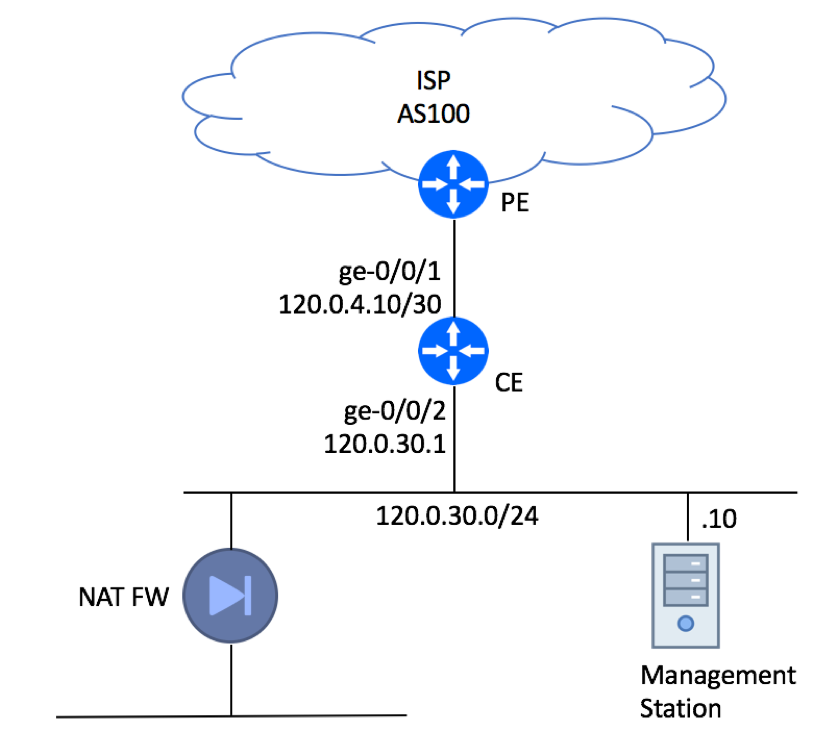
Please note, that the Management Station is connected directly to the LAN interface for illustration purpose only. In real production deployments it must be protected by a firewall.
BGP Configuration
BGP configuration can be split in the following tasks:
- Accept the default route from the ISP while discarding all other advertisements that might be sent to your CE
- Advertise your subnet (120.0.30.0/24) while making sure that no other routers are erroneously injected
- Secure BGP session by configuring a MD5 key
The actual configuration is comprised of the following blocks:
- Configure Local AS Number:
set routing-options autonomous-system 65001
- Configure Two prefix lists – one with the subnet you’ll advertise upstream and the other one with the default route you’ll be receiving from your ISP:
set policy-options prefix-list LocallyOriginated 120.0.30.0/24 set policy-options prefix-list Default 0.0.0.0/0
- Create Policy Statements for the locally originated and default route:
set policy-options policy-statement Direct-To-BGP term 10 from protocol direct set policy-options policy-statement Direct-To-BGP term 10 from prefix-list LocallyOriginated set policy-options policy-statement Direct-To-BGP term 10 then accept set policy-options policy-statement Direct-To-BGP term 999 then reject set policy-options policy-statement Default term 10 from prefix-list Default set policy-options policy-statement Default term 10 then accept set policy-options policy-statement Default term 999 then reject
- Configure BGP Group for your Upstream ISP. Configure the “export” statement to advertise your 120.0.30.0/24 subnet to the Internet and “import” statement to receive the default route. Configure MD5 Authentication Key. Make sure the description field includes the Circuit ID assigned to your link and ISP’s contact phone so you would not need to search for this information in an event of an outage.
set protocols bgp log-updown set protocols bgp group ISP-AS100 type external set protocols bgp group ISP-AS100 import Default set protocols bgp group ISP-AS100 authentication-key "$9$9UPDt0IylMNdsEcds24DjCtu" set protocols bgp group ISP-AS100 export Direct-To-BGP set protocols bgp group ISP-AS100 peer-as 100 set protocols bgp group ISP-AS100 neighbor 120.0.4.9 description "ISP FastAccess: Circuit GD8AJ12B: ISP NOC 800-111-2222"
Securing the Router
Next step is to secure the router itself. But default, it will pass any traffic (with some exceptions, not covered in this article) and accept connections from anywhere on the Internet. Your job is to make sure that only trusted sources can communicate with your device (control plane protection) and spoofed traffic is not allowed in and out of your network (data plane protection).
Data Plane Protection
We’ll start with the data plane, where we need to take care of packets leaving your network and packets coming in.
In our example, we were assigned a single IP subnet to be used within our network – 120.0.30.0/24. As such, we should only allow traffic originated from this network as well our ISP-facing WAN interface to go out. There are a few ways to achieve this goal – configure uRFP on LAN interface, inbound firewall filter on LAN, or outbound filter on WAN. We’ll use the latter approach by setting up outbound WAN filter:
set firewall family inet filter accept-local term 10 from source-address 120.0.30.0/24 set firewall family inet filter accept-local term 10 then accept set firewall family inet filter accept-local term 20 from source-address 120.0.4.10/32 set firewall family inet filter accept-local term 20 then accept set firewall family inet filter discard-any term 10 then discard set interfaces ge-0/0/1 unit 0 family inet filter output-list accept-local set interfaces ge-0/0/1 unit 0 family inet filter output-list discard-any
We also need to make sure that the traffic coming from the Internet has a valid source IP. As we do not receive the full BGP feed from our upstream provider and cannot rely on uRPF, we will need to configure static filter that will discard all known “bad” sources also known as Martian blocks, while allowing all other traffic in:
set firewall family inet filter discard-martian term rfc919 from source-address 255.255.255.255/32 set firewall family inet filter discard-martian term rfc919 then discard set firewall family inet filter discard-martian term rfc1122 from source-address 0.0.0.0/8 set firewall family inet filter discard-martian term rfc1122 from source-address 127.0.0.0/8 set firewall family inet filter discard-martian term rfc1122 from source-address 240.0.0.0/4 set firewall family inet filter discard-martian term rfc1122 then discard set firewall family inet filter discard-martian term rfc1918 from source-address 10.0.0.0/8 set firewall family inet filter discard-martian term rfc1918 from source-address 172.16.0.0/12 set firewall family inet filter discard-martian term rfc1918 from source-address 192.168.0.0/16 set firewall family inet filter discard-martian term rfc1918 then discard set firewall family inet filter discard-martian term rfc2544 from source-address 198.18.0.0/15 set firewall family inet filter discard-martian term rfc2544 then discard set firewall family inet filter discard-martian term rfc3171 from source-address 224.0.0.0/4 set firewall family inet filter discard-martian term rfc3171 then discard set firewall family inet filter discard-martian term rfc3927 from source-address 169.254.0.0/16 set firewall family inet filter discard-martian term rfc3927 then discard set firewall family inet filter discard-martian term rfc5736 from source-address 192.0.0.0/24 set firewall family inet filter discard-martian term rfc5736 then discard set firewall family inet filter discard-martian term rfc5737 from source-address 192.0.2.0/24 set firewall family inet filter discard-martian term rfc5737 from source-address 198.51.100.0/24 set firewall family inet filter discard-martian term rfc5737 from source-address 203.0.113.0/24 set firewall family inet filter discard-martian term rfc5737 then discard set firewall family inet filter discard-martian term rfc6598 from source-address 100.64.0.0/10 set firewall family inet filter discard-martian term rfc6598 then discard set firewall family inet filter accept-any term 10 then accept set interfaces ge-0/0/1 unit 0 family inet filter input-list discard-martian set interfaces ge-0/0/1 unit 0 family inet filter input-list discard-local set interfaces ge-0/0/1 unit 0 family inet filter input-list accept-any
Control Plane Protection
While it is important to discard malicious traffic that tries to pass through your router, it is even more important to drop bad packets destined to your infrastructure device. All router-bound traffic must be dropped unless it comes from a known and trusted source. In our example, we can trust ISP’s PE router as we’ll be establishing EBGP session with that device and dedicated server (120.0.30.10) used for device management. We will also allow Ping and Traceroute packets. Everything else will be dropped.
set firewall family inet filter accept-protocols term bgp from source-address 120.0.4.9/32 set firewall family inet filter accept-protocols term bgp from protocol tcp set firewall family inet filter accept-protocols term bgp from port bgp set firewall family inet filter accept-protocols term bgp then accept set firewall family inet filter accept-management term ssh from source-address 120.0.30.10/32 set firewall family inet filter accept-management term ssh from source-address 192.168.3.0/24 set firewall family inet filter accept-management term ssh from protocol tcp set firewall family inet filter accept-management term ssh from destination-port ssh set firewall family inet filter accept-management term ssh then accept set firewall family inet filter accept-management term snmp from source-address 120.0.30.10/32 set firewall family inet filter accept-management term snmp from protocol udp set firewall family inet filter accept-management term snmp from destination-port snmp set firewall family inet filter accept-management term snmp then accept set firewall family inet filter accept-management term ntp from source-address 120.0.30.10/32 set firewall family inet filter accept-management term ntp from protocol udp set firewall family inet filter accept-management term ntp from port ntp set firewall family inet filter accept-management term ntp then accept set firewall family inet filter accept-management term dns from source-address 120.0.30.10/32 set firewall family inet filter accept-management term dns from protocol udp set firewall family inet filter accept-management term dns from protocol tcp set firewall family inet filter accept-management term dns from source-port 53 set firewall family inet filter accept-management term dns then accept set firewall family inet filter accept-monitoring term icmp from protocol icmp set firewall family inet filter accept-monitoring term icmp from icmp-type echo-reply set firewall family inet filter accept-monitoring term icmp from icmp-type echo-request set firewall family inet filter accept-monitoring term icmp from icmp-type time-exceeded set firewall family inet filter accept-monitoring term icmp from icmp-type unreachable set firewall family inet filter accept-monitoring term icmp from icmp-type parameter-problem set firewall family inet filter accept-monitoring term icmp then accept set firewall family inet filter accept-monitoring term traceroute-udp from protocol udp set firewall family inet filter accept-monitoring term traceroute-udp from destination-port 33435-33450 set firewall family inet filter accept-monitoring term traceroute-udp then accept set firewall family inet filter discard-any term 10 then discard
These filters will be applied to Lo0 interface (Juniper’s Control plane interface).
set interfaces lo0 unit 0 family inet filter input-list accept-protocols set interfaces lo0 unit 0 family inet filter input-list accept-management set interfaces lo0 unit 0 family inet filter input-list accept-monitoring set interfaces lo0 unit 0 family inet filter input-list discard-any
Complete Router Configuration
Configuration in Set Format:
set system host-name CE3-Downstream3 set system domain-name bgphelp.com set system time-zone America/New_York set system no-redirects set system root-authentication encrypted-password "abc" set system name-server 120.0.30.10 set system login user bgphelp uid 2000 set system login user bgphelp class super-user set system login user bgphelp authentication encrypted-password "abc" set system services ssh root-login deny set system services ssh protocol-version v2 set system syslog user * any emergency set system syslog host 120.0.30.10 any info set system syslog file messages any any set system syslog file messages authorization info set system syslog file interactive-commands interactive-commands any set system ntp server 120.0.30.10 set interfaces ge-0/0/1 description "'CE3->PE2'" set interfaces ge-0/0/1 unit 0 family inet filter input-list discard-martian set interfaces ge-0/0/1 unit 0 family inet filter input-list discard-local set interfaces ge-0/0/1 unit 0 family inet filter input-list accept-any set interfaces ge-0/0/1 unit 0 family inet filter output-list accept-local set interfaces ge-0/0/1 unit 0 family inet filter output-list discard-any set interfaces ge-0/0/1 unit 0 family inet address 120.0.4.10/30 set interfaces ge-0/0/2 description "LAN Segment" set interfaces ge-0/0/2 unit 0 family inet address 120.0.30.1/24 set interfaces lo0 unit 0 family inet filter input-list accept-protocols set interfaces lo0 unit 0 family inet filter input-list accept-management set interfaces lo0 unit 0 family inet filter input-list accept-monitoring set interfaces lo0 unit 0 family inet filter input-list discard-any set snmp location MarsDC:BAY12334:U123 set snmp contact "IP NOC 1-345-12-1234" set snmp community f0ryoureyesonly clients 120.0.30.10/32 set snmp trap-group all version v2 set snmp trap-group all targets 120.0.30.10 set routing-options autonomous-system 65001 set protocols bgp log-updown set protocols bgp group ISP-AS100 type external set protocols bgp group ISP-AS100 import Default set protocols bgp group ISP-AS100 authentication-key "$9$9UPDt0IylMNdsEcds24DjCtu" set protocols bgp group ISP-AS100 export Direct-To-BGP set protocols bgp group ISP-AS100 peer-as 100 set protocols bgp group ISP-AS100 neighbor 120.0.4.9 description "ISP FastAccess: Circuit GD8AJ12B: ISP NOC 800-111-2222" set policy-options prefix-list LocallyOriginated 120.0.30.0/24 set policy-options prefix-list Default 0.0.0.0/0 set policy-options policy-statement Default term 10 from prefix-list Default set policy-options policy-statement Default term 10 then accept set policy-options policy-statement Default term 999 then reject set policy-options policy-statement Direct-To-BGP term 10 from protocol direct set policy-options policy-statement Direct-To-BGP term 10 from prefix-list LocallyOriginated set policy-options policy-statement Direct-To-BGP term 10 then accept set policy-options policy-statement Direct-To-BGP term 999 then reject set security forwarding-options family mpls mode packet-based set firewall family inet filter discard-martian term rfc919 from source-address 255.255.255.255/32 set firewall family inet filter discard-martian term rfc919 then discard set firewall family inet filter discard-martian term rfc1122 from source-address 0.0.0.0/8 set firewall family inet filter discard-martian term rfc1122 from source-address 127.0.0.0/8 set firewall family inet filter discard-martian term rfc1122 from source-address 240.0.0.0/4 set firewall family inet filter discard-martian term rfc1122 then discard set firewall family inet filter discard-martian term rfc1918 from source-address 10.0.0.0/8 set firewall family inet filter discard-martian term rfc1918 from source-address 172.16.0.0/12 set firewall family inet filter discard-martian term rfc1918 from source-address 192.168.0.0/16 set firewall family inet filter discard-martian term rfc1918 then discard set firewall family inet filter discard-martian term rfc2544 from source-address 198.18.0.0/15 set firewall family inet filter discard-martian term rfc2544 then discard set firewall family inet filter discard-martian term rfc3171 from source-address 224.0.0.0/4 set firewall family inet filter discard-martian term rfc3171 then discard set firewall family inet filter discard-martian term rfc3927 from source-address 169.254.0.0/16 set firewall family inet filter discard-martian term rfc3927 then discard set firewall family inet filter discard-martian term rfc5736 from source-address 192.0.0.0/24 set firewall family inet filter discard-martian term rfc5736 then discard set firewall family inet filter discard-martian term rfc5737 from source-address 192.0.2.0/24 set firewall family inet filter discard-martian term rfc5737 from source-address 198.51.100.0/24 set firewall family inet filter discard-martian term rfc5737 from source-address 203.0.113.0/24 set firewall family inet filter discard-martian term rfc5737 then discard set firewall family inet filter discard-martian term rfc6598 from source-address 100.64.0.0/10 set firewall family inet filter discard-martian term rfc6598 then discard set firewall family inet filter discard-local term 10 from source-address 120.0.30.0/24 set firewall family inet filter discard-local term 10 then discard set firewall family inet filter accept-any term 10 then accept set firewall family inet filter accept-local term 10 from source-address 120.0.30.0/24 set firewall family inet filter accept-local term 10 then accept set firewall family inet filter accept-local term 20 from source-address 120.0.4.10/32 set firewall family inet filter accept-local term 20 then accept set firewall family inet filter discard-any term 10 then discard set firewall family inet filter accept-protocols term bgp from source-address 120.0.4.9/32 set firewall family inet filter accept-protocols term bgp from protocol tcp set firewall family inet filter accept-protocols term bgp from port bgp set firewall family inet filter accept-protocols term bgp then accept set firewall family inet filter accept-management term ssh from source-address 120.0.30.10/32 set firewall family inet filter accept-management term ssh from source-address 192.168.3.0/24 set firewall family inet filter accept-management term ssh from protocol tcp set firewall family inet filter accept-management term ssh from destination-port ssh set firewall family inet filter accept-management term ssh then accept set firewall family inet filter accept-management term snmp from source-address 120.0.30.10/32 set firewall family inet filter accept-management term snmp from protocol udp set firewall family inet filter accept-management term snmp from destination-port snmp set firewall family inet filter accept-management term snmp then accept set firewall family inet filter accept-management term ntp from source-address 120.0.30.10/32 set firewall family inet filter accept-management term ntp from protocol udp set firewall family inet filter accept-management term ntp from port ntp set firewall family inet filter accept-management term ntp then accept set firewall family inet filter accept-management term dns from source-address 120.0.30.10/32 set firewall family inet filter accept-management term dns from protocol udp set firewall family inet filter accept-management term dns from protocol tcp set firewall family inet filter accept-management term dns from source-port 53 set firewall family inet filter accept-management term dns then accept set firewall family inet filter accept-monitoring term icmp from protocol icmp set firewall family inet filter accept-monitoring term icmp from icmp-type echo-reply set firewall family inet filter accept-monitoring term icmp from icmp-type echo-request set firewall family inet filter accept-monitoring term icmp from icmp-type time-exceeded set firewall family inet filter accept-monitoring term icmp from icmp-type unreachable set firewall family inet filter accept-monitoring term icmp from icmp-type parameter-problem set firewall family inet filter accept-monitoring term icmp then accept set firewall family inet filter accept-monitoring term traceroute-udp from protocol udp set firewall family inet filter accept-monitoring term traceroute-udp from destination-port 33435-33450 set firewall family inet filter accept-monitoring term traceroute-udp then accept
Configuration in Curly Braces Format:
system {
host-name CE3-Downstream3;
domain-name bgphelp.com;
time-zone America/New_York;
no-redirects;
root-authentication {
encrypted-password "abc"; ## SECRET-DATA
}
name-server {
120.0.30.10;
}
login {
user bgphelp {
uid 2000;
class super-user;
authentication {
encrypted-password "abc"; ## SECRET-DATA
}
}
}
services {
ssh {
protocol-version v2;
}
netconf {
ssh;
}
}
syslog {
user * {
any emergency;
}
host 120.0.30.10 {
any info;
}
file messages {
any any;
authorization info;
}
file interactive-commands {
interactive-commands any;
}
}
archival {
configuration {
transfer-on-commit;
archive-sites {
"scp://cfg:abc@192.168.3.210/home/cfg/config-backups/";
}
}
}
ntp {
server 192.168.3.210;
}
}
interfaces {
ge-0/0/1 {
description "'CE3->PE2'";
unit 0 {
family inet {
filter {
input-list [ discard-martian discard-local accept-any ];
output-list [ accept-local discard-any ];
}
address 120.0.4.10/30;
}
}
}
ge-0/0/2 {
description "LAN Segment";
unit 0 {
family inet {
address 120.0.30.1/24;
}
}
}
lo0 {
unit 0 {
family inet {
filter {
input-list [ accept-protocols accept-management accept-monitoring discard-any ];
}
}
}
}
}
snmp {
location MarsDC:BAY12334:U123;
contact "IP NOC 1-345-12-1234";
community f0ryoureyesonly {
clients {
120.0.30.10/32;
}
}
trap-group all {
version v2;
targets {
120.0.30.10;
}
}
}
routing-options {
static {
route 192.168.74.0/24 {
next-hop 192.168.3.18;
no-readvertise;
}
}
autonomous-system 65001;
}
protocols {
bgp {
log-updown;
group ISP-AS100 {
type external;
import Default;
authentication-key "$9$9UPDt0IylMNdsEcds24DjCtu"; ## SECRET-DATA
export Direct-To-BGP;
peer-as 100;
neighbor 120.0.4.9 {
description "ISP FastAccess: Circuit GD8AJ12B: ISP NOC 800-111-2222";
}
}
}
}
policy-options {
prefix-list LocallyOriginated {
120.0.30.0/24;
}
prefix-list Default {
0.0.0.0/0;
}
policy-statement Default {
term 10 {
from {
prefix-list Default;
}
then accept;
}
term 999 {
then reject;
}
}
policy-statement Direct-To-BGP {
term 10 {
from {
protocol direct;
prefix-list LocallyOriginated;
}
then accept;
}
term 999 {
then reject;
}
}
}
firewall {
family inet {
filter discard-martian {
term rfc919 {
from {
source-address {
255.255.255.255/32;
}
}
then {
discard;
}
}
term rfc1122 {
from {
source-address {
0.0.0.0/8;
127.0.0.0/8;
240.0.0.0/4;
}
}
then {
discard;
}
}
term rfc1918 {
from {
source-address {
10.0.0.0/8;
172.16.0.0/12;
192.168.0.0/16;
}
}
then {
discard;
}
}
term rfc2544 {
from {
source-address {
198.18.0.0/15;
}
}
then {
discard;
}
}
term rfc3171 {
from {
source-address {
224.0.0.0/4;
}
}
then {
discard;
}
}
term rfc3927 {
from {
source-address {
169.254.0.0/16;
}
}
then {
discard;
}
}
term rfc5736 {
from {
source-address {
192.0.0.0/24;
}
}
then {
discard;
}
}
term rfc5737 {
from {
source-address {
192.0.2.0/24;
198.51.100.0/24;
203.0.113.0/24;
}
}
then {
discard;
}
}
term rfc6598 {
from {
source-address {
100.64.0.0/10;
}
}
then {
discard;
}
}
}
filter discard-local {
term 10 {
from {
source-address {
120.0.30.0/24;
}
}
then {
discard;
}
}
}
filter accept-any {
term 10 {
then accept;
}
}
filter accept-local {
/* LAN Segment */
term 10 {
from {
source-address {
120.0.30.0/24;
}
}
then accept;
}
/* Point-To-Point WAN Interface */
term 20 {
from {
source-address {
120.0.4.10/32;
}
}
then accept;
}
}
filter discard-any {
term 10 {
then {
discard;
}
}
}
filter accept-protocols {
term bgp {
from {
source-address {
120.0.4.9/32;
}
protocol tcp;
port bgp;
}
then accept;
}
}
filter accept-management {
term ssh {
from {
source-address {
120.0.30.10/32;
192.168.3.0/24;
}
protocol tcp;
port ssh;
}
then accept;
}
term snmp {
from {
source-address {
120.0.30.10/32;
}
protocol udp;
destination-port snmp;
}
then accept;
}
term ntp {
from {
source-address {
120.0.30.10/32;
}
protocol udp;
port ntp;
}
then accept;
}
term dns {
from {
source-address {
120.0.30.10/32;
}
protocol [ udp tcp ];
source-port 53;
}
then accept;
}
term netconf {
from {
source-address {
120.0.30.10/32;
192.168.3.0/24;
}
protocol tcp;
destination-port 830;
}
then accept;
}
}
filter accept-monitoring {
term icmp {
from {
protocol icmp;
icmp-type [ echo-reply echo-request time-exceeded unreachable source-quench router-advertisement parameter-problem ];
}
then accept;
}
term traceroute-udp {
from {
protocol udp;
destination-port 33435-33450;
}
then accept;
}
}
}
}
BGP Best Practices or Dissecting RFC 7454
In this article, we will focus on the RFC 7547. This RFC covers BGP Operations and Security best current practices and needs to be understood and implemented by any organization running BGP in production.
Introduction
RFC 7547 recommendations can be split into the following categories:
- BGP Session Protection
- Prefix Filtering Recommendations
- AS-Path Filtering Recommendations
- Next-Hop Filtering
- Optional BGP Community Scrubbing
- Traffic Filtering Recommendations
In this article, we will use Roman Numerals (I, II, etc) to identify BGP protection mechanisms, Arabic Numerals (1,2, etc) to identify Traffic Filtering, Uppercase Letters (A, B, etc) to identify Prefix Filtering, and Lowercase Letter (a,b, etc) to identify AS-Path filtering and Greek Letters (α, β) to identify BGP scrubbing.
Figure below shows depicts peering routers connected to upstream, private, IXP and downstream peers.
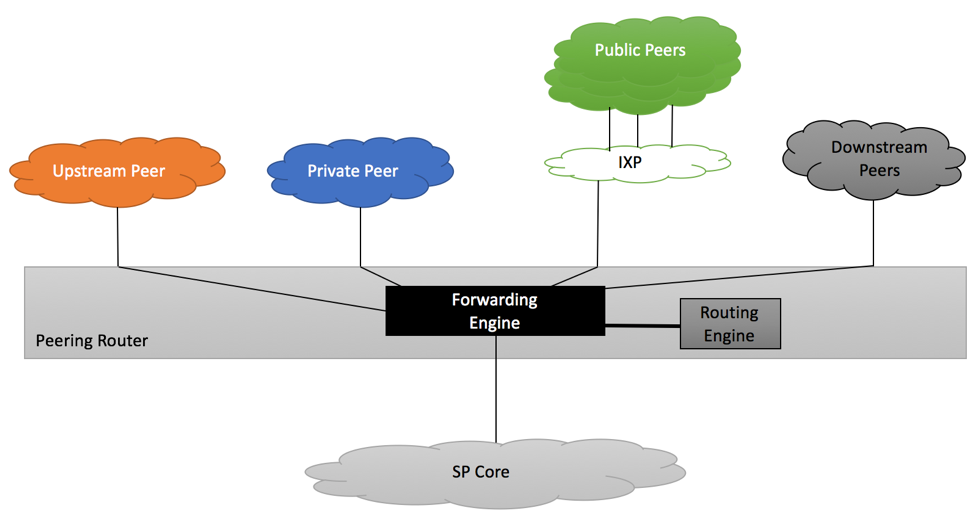
As most of the modern routers do, our sample router has a dedicated forwarding engine responsible for forwarding packets and a dedicated routing engine responsible for participating in routing protocols, building Routing Information Base (RIB) and Forwarding Information Base (FIB) tables. While actual vendors’ implementations will vary between routers’ models, best practices discussed in this article are generic enough to be applicable to the majority of vendors.
BGP Protection
Group of BGP Protection mechanisms is responsible for maintaining stability of BGP sessions, as well as providing anti-spoofing and bogus route-injection protection mechanisms. We will also add “maximum-prefix” protection mechanism to this category, as it helps to protect against operators’ mistakes.
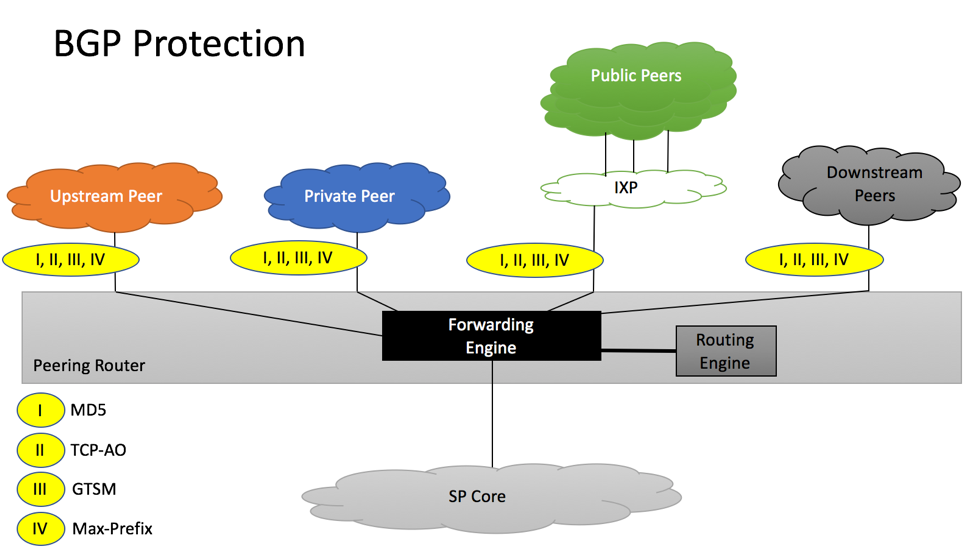
I. GTSM (TTL Security)
GTSM – Generalized TTL Security Mechanisms, also known as TTL security, defined in RFC 5082. GTSM (TTL Security) is a mechanism that checks TTL value of incoming IP Packets in order to make sure they have not been spoofed. Directly connected BGP peers will set IP TTL value to 255, making it impossible to deliver spoofed IP with TTL=255 packets via non-directly connected interfaces. As per section 5.2 of RFC 7454 GTSM should be implemented.
Configuration Examples:
II. TCP-AO (TCP Authentication Option)
TCP-AO – TCP Authentication Option is a stronger protection mechanism than traditionally used MD5, it is described in RFC 5925. At some point, it is expected to replace MD5 for session protection. It has not been widely adopted due to the lack of implementation from equipment vendors.
Section 5.1 of RFC 7454 recommends, although does not require, leveraging either MD5 or TCP-AO for session protection.
No configuration examples due to lack of vendors’ implementation.
III. MD5
MD5 – Protection of the TCP session header, described in RFC 2385. MD5 is a TCP session protection mechanism that has been available for many years and is supported by the vast majority of equipment manufacturers. It has become the de-facto standard for BGP session protection. Although it has been made obsolete by TCP-AO protection, it is still used for the majority of BGP peering sessions.
Configuration Examples (Simple Key and Key-Chains):
- Cisco IOS
- Cisco IOS-XR
- JunOS
- Packet Trace – Basic MD5 Authentication
- Packet Trace – MD5 with Key-Chain
IV. Max-Prefix
Maximum-Prefix Limit is one of the commonly used safety mechanisms that will bring down BGP session if the number of routes advertised by the peer exceeds pre-configured limit. Section 8 of RFC 7454 provides the following recommendations:
- From public and private peers, it is recommended to have the limit set to either a lower than the number of routes on the Internet, or to a specific number for each peer based on the advertised number of routes plus some headroom. From the author’s experience, setting the number to below the number of routes on the Internet is too risky and should be avoided. There have been situations where public and private peers would make an error and leak the entire BGP table to their peering partners, causing major network instability. Author prefers setting session reset limit to 2x the number of routes normally advertised by the peer and session warning limit to 1.5x number of routes. Your NOC should monitor logs for warning threshold violations and adjust limits accordingly.
- From upstream, the number of routes should be set higher than the number of routes on the Internet, but not higher that the capabilities of your routers. For example, if FIB tables of your devices can support up to 1 Million IPv4 routes, you can set the limit to be 950,000 routes. While resetting BGP sessions with your upstream providers is never a good thing, damage caused by reset is much lower than that caused by FIB exhaustion. For more information, please refer to our article on BGP Table Size analysis (http://www.bgphelp.com/2017/01/01/bgpsize/).
MD5, TCP-AO and GTSM have to be configured on both sides of the BGP session. Max-Prefix can be configured on one side only.
Prefix Filtering
Prefix-filtering policies are responsible for discarding bogus route-advertisements to and from BGP peers. Examples of these bogus advertisements are prefixes from RFC1918 address space, to specific routes (>24), unallocated prefixes.
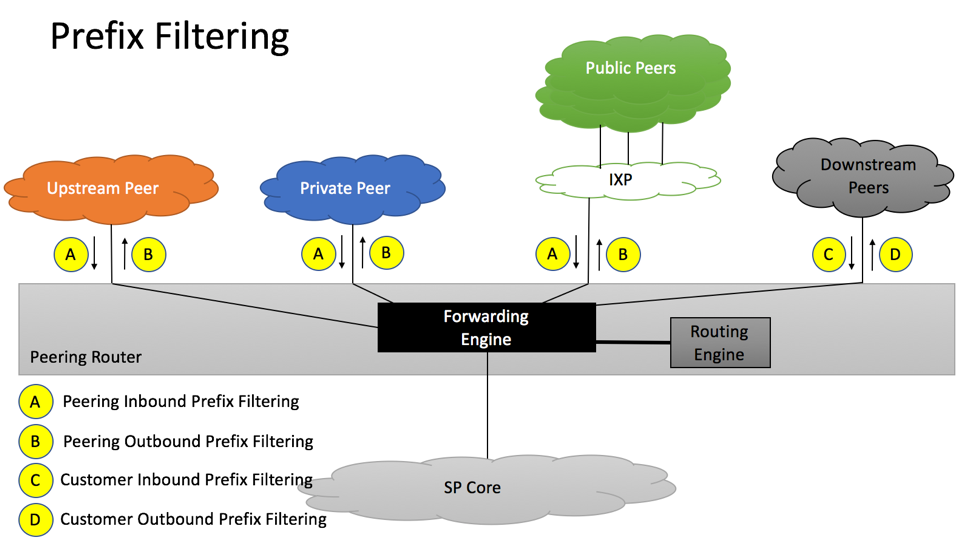
Route-filtering should be implemented on each BGP session maintained by the service provider:
- A. Private/Public/Transit Inbound Prefix Filtering
- B. Private/Public/Transit Outbound Prefix Filtering
- C. Downstream Inbound Prefix Filtering
- D. Downstream Outbound Prefix Filtering
A. Inbound Prefix Filtering from Private/Public/Transit Peers
RFC 7475 provides similar recommendations for route filtering from Upstream Providers (section 6.2.3) and route-filtering from private and public peers (section 6.2.1). Because of this, there is very little difference in filtering policies, allowing us to combine them in one recommendation.
As per Section 6.2.1.1.1 of RFC 7475, the following prefixes should not be accepted from peers
- Special-Purpose Prefixes (RFC 7475 Section 6.1.1)
- Unallocated Prefixes (RFC 7475 Section 6.1.2)
- Prefixes that are too specific (RFC 7475 Section 6.1.3)
- Prefixes belonging to the local AS (RFC 7475 Section 6.1.4)
- IXP LAN Prefixes (RFC 7475 Section 6.1.5), other than authorized ASes (RFC 7475 Section 6.1.5)
- The Default Route (RFC 7475 Section 6.1.6)
Section 6.2.1.1.2 of RFC 7475 also provides recommendations for “Strict” inbound filtering option, which we consider to be too risky and will not cover in this document.
B. Outbound Prefix Filtering towards Private/Public/Transit Peers
As per Section 6.2.1.2 of RFC 7475, the following prefixes should not be accepted from peers
- Special-Purpose Prefixes (RFC 7475 Section 6.1.1)
- Prefixes that are too specific (RFC 7475 Section 6.1.3)
- IXP LAN Prefixes (RFC 7475 Section 6.1.5)
- The Default Route (RFC 7475 Section 6.1.6)
You also need to make sure that only authorized prefixes (those advertised by your AS and downstream customers) are being sent.
C. Inbound Prefix Filtering from Customers
General recommendations provided in Section 6.2.2.1 of RFC 7475 state that “only customer prefixes SHOULD be accepted, all others SHOULD be discarded.” The list of allowed prefixes should be manually built by the network provisioner after validating that customer prefixes are indeed allocated to the client by IP address management authorities.
In some cases, if customer advertises too many prefixes or has BGP clients of their own, customer-specific filters can be replaced with generic filters previously described in “Inbound Filtering from Private/Public/Transit Peers” section of the paper.
D. Outbound Prefix Filtering towards Customers
Depending on the customer preferences, they might want to receive
- The default route only
- Full Internet routing table
- Subset of the Full Internet table (e.g. only the routes received via public and private peers, but not the transit routes)
- The default route in addition to the Full or Partial Internet view
Generic recommendation described in Section 6.2.2.2 of RFC 7454 states that the following prefixes should not be sent to the customer:
- Special-Purpose Prefixes (RFC 7475 Section 6.1.1)
- Prefixes that are too specific (RFC 7475 Section 6.1.3)
- The Default Route (RFC 7475 Section 6.1.6), for those customers not willing to receive it
AS-Path Filtering
Section 9 of RFC 7454 provides a number of AS-Path Filtering recommendations that should be implemented on upstream/private/public peering sessions and customer sessions.
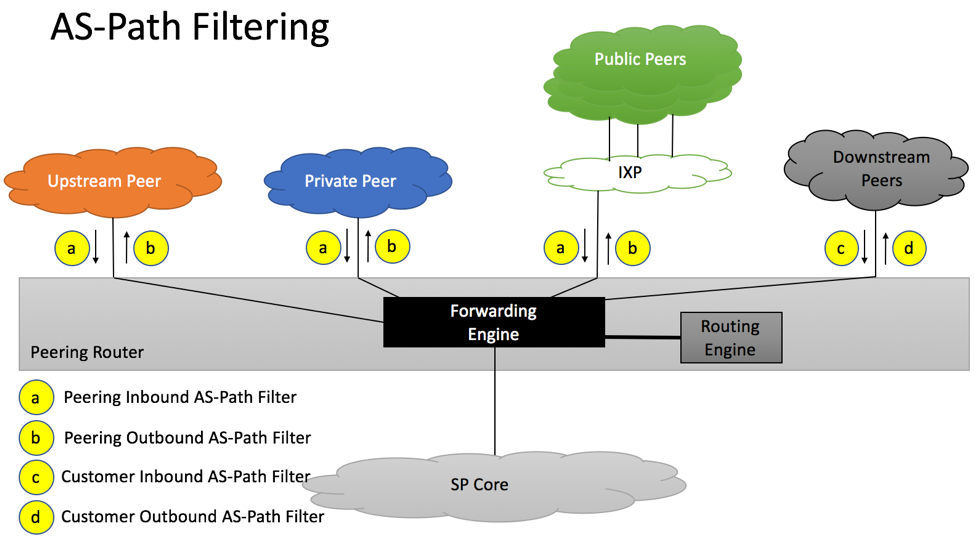
Similar to how we analyzed Prefix Filtering recommendations in the previous chapter, we will review AS-Path Filtering recommendations below.
a. Inbound AS-Path Filtering from Private/Public/Transit Peers
Section 9 of RFC 7454 recommends the following:
- Private AS numbers should not be accepted, unless used for special purposes such as black-hole origination
- AS Paths with the first AS number not the one of the peer should not be accepted, unless originated by IXP’s router server
- Do not accept your own AS number in the AS path
b. Outbound AS-Path Filtering from Private/Public/Transit Peers
Section 9 of RFC 7454 recommends the following:
- Do not originate prefixes with nonempty AS Paths, unless you intend to provide transit for these prefixes
- Do not originate prefixes with upstream AS numbers in the AS Path, unless you intend to provide transit to these prefixes
- Do not advertise Private AS Paths, unless there is a special “private” arrangement with your peers
c. Inbound AS-Path Filtering from Downstream Customers
Section 9 of RFC 7454 recommends the following:
- Only accept 2-byte and 4-byte AS paths containing ASNs belonging to the customer.
- If this is not possible, accept only path lengths relevant to the type of the customer, while discourage excessive prepending
- Do not accept your own AS number in the AS path
d. Outbound AS-Path Filtering from Downstream Customers
- Do not advertise Private AS Paths, unless there is a special “private” arrangement with your customers
Next-Hop Filtering
BGP can advertise prefixes with a third-party next hop, thus directing packets not to the peer announcing the prefix but somewhere else. This mechanism is commonly used at Internet Exchange Points, where prefixes will be announced by IXP’s route-server.
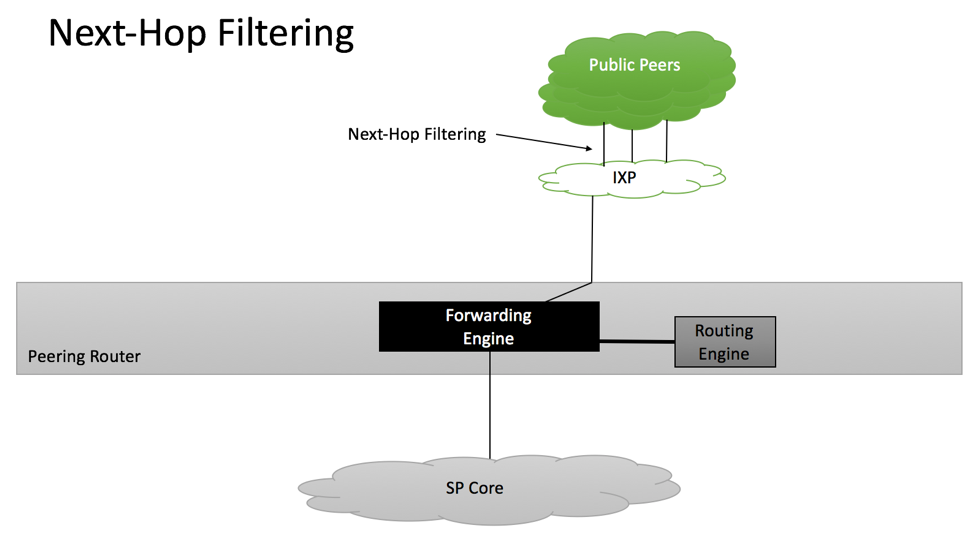
Section 10 of RFC 7545 recommends the following policies at IXP locations:
- For direct peering (without router-server), apply inbound BGP policy that would set next-hop for the accepted prefix to BGP peer IP address
- For indirect peering (with IXP’s route-server), accept next-hop attribute advertised by the route-server
BGP Community Scrubbing
Section 11 of RFC 7454 provides the following optional community scrubbing recommendations.
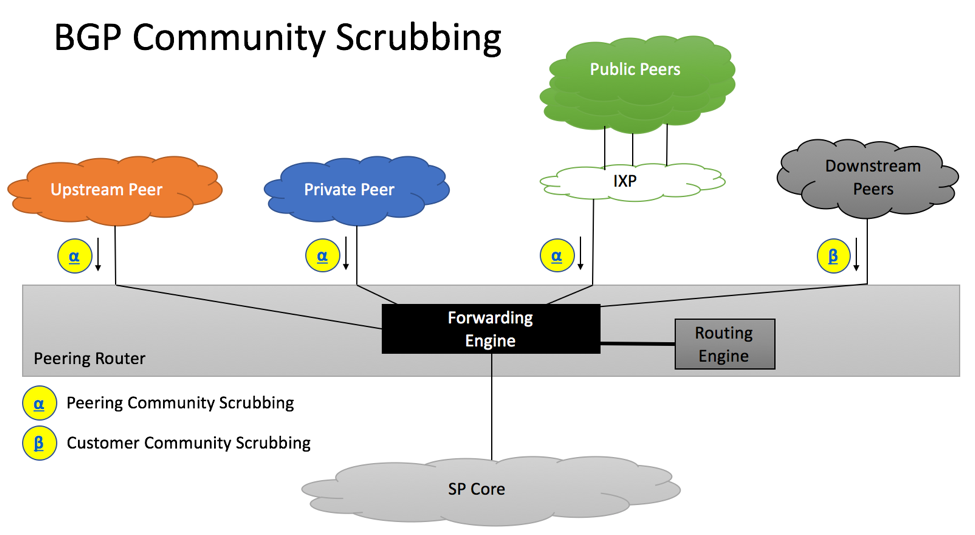
- Ingress BGP peering policy applied to transit/public/private and downstream peers should remove all inbound communities with SP’s number in the high-order bits, except for the ones used for signaling (e.g. setting BGP Local Preference).
- Ingress BGP Policy should not remove other communities, as those communities can be used to communicate with upstream providers.
Traffic Filtering
Section 4 of RFC 7454 provides basic recommendations when it comes to traffic filtering and BGP.
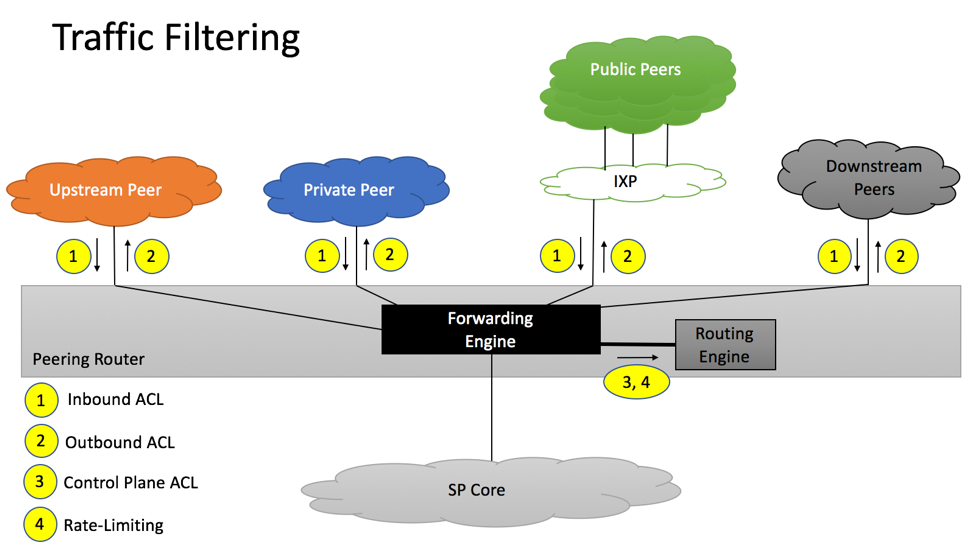
All packets destined to TCP Port 179 and not originated from addresses of configured BGP peers should be discarded. If supported, Control Plane ACL (point 3 on the diagram) should be used. If not supported, ACL applied to each peer-facing port (point 1) should be used.
If supported, BGP Rate-Limiting (point 4) should also be implemented, to make sure that the number of BGP packets per second does not exceed platform’s capability.
Generic Control Plane protection recommendations are out of RFC 7454 scope and are covered in RFC 6192.
